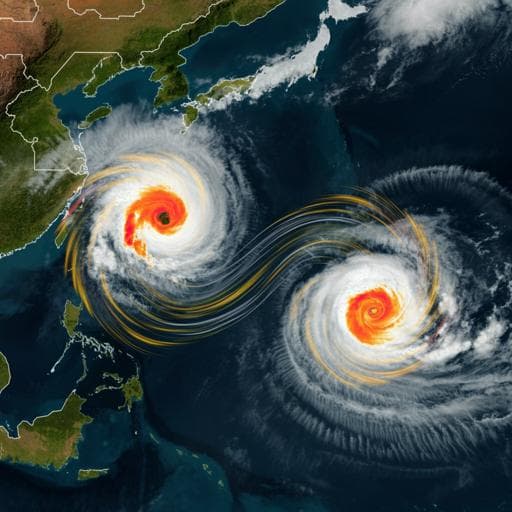
Earth Sciences
Unraveling the strong covariability of tropical cyclone activity between the Bay of Bengal and the South China Sea
Z. Wu, C. Hu, et al.
Discover the intriguing link between tropical cyclone activity in the Bay of Bengal and South China Sea, revealing how sea surface temperature anomalies shape weather patterns, as explored by Zeming Wu and colleagues.
~3 min • Beginner • English
Introduction
The study investigates whether tropical cyclone (TC) activity in the Bay of Bengal (BOB) and the South China Sea (SCS) co-varies during the late season (October–December), explores the underlying mechanisms, and assesses the relative roles of tropical Indian and Pacific Ocean sea surface temperature (SST) anomalies. Although the BOB hosts fewer TCs annually, post-monsoon events are impactful and constitute a large fraction of annual activity. The SCS is also an active basin with seasonally distinct tracks. Prior work shows strong influences of ENSO and the Indian Ocean Dipole (IOD) on TC characteristics in both basins. Given that Indo-Pacific SST anomalies broadly modulate atmospheric circulation over BOB–SCS, the authors hypothesize coherent, inter-basin covariability of TC activity and examine whether this is linked to an intrinsic tripolar Indo-Pacific SST mode. Understanding such covariability has implications for regional risk management and preparedness in densely populated, vulnerable coastal regions.
Literature Review
ENSO strongly modulates BOB TC genesis frequency, lifetime, and track, with La Niña favoring higher BOB TC frequency and intensity via warmer SSTs, reduced vertical wind shear, and enhanced mid-level humidity and low-level cyclonic circulation; genesis shifts eastward during La Niña with more recurving tracks. SCS TC frequency is also above normal during La Niña due to similar favorable environmental changes. IOD impacts BOB TCs by altering convection over the eastern Indian Ocean, inducing cyclonic or anticyclonic anomalies over BOB and modulating low-level vorticity and genesis frequency. Fewer studies have specifically addressed IOD–SCS TC links, though eastern/tropical Indian Ocean SST anomalies can impact WNP TCs by exciting Kelvin waves and inducing circulation anomalies. Prior work emphasizes basin-scale SST influences on atmospheric circulation that could produce coherent TC variability across BOB and SCS, but the inter-basin covariability, and the relative contributions of Indian versus Pacific SST anomalies, have not been fully clarified.
Methodology
Data and period: TC best-track data from JTWC/IBTrACS for 1979–2019 (1-min sustained winds), with robustness checks using CMA best-track data east of 100°E. Atmospheric fields from ERA5; precipitation from GPCP; SST from merged NOAA ERSSTv5 and Hadley Centre SST (both 2°×2°). ENSO (Niño3.4) and IOD (DMI) indices from NOAA PSL.
TC selection and processing: Only TCs reaching at least tropical storm intensity (Vmax > 33 kt) are considered. Genesis is the first best-track record. Track and genesis densities are computed as occurrence frequencies on 5°×5° grids, followed by spatial smoothing (weight 1.0 at center, 0.5 at sides, 0.3 at corners).
Regional/basin definitions and TC types: BOB region: 80°–100°E, 5°–30°N; SCS region: 100°–120°E, 5°–30°N. Local TC (LTC) vs migrated TC (MTC): A BOB LTC forms west of 100°E and enters BOB; a BOB MTC forms east of 100°E and enters BOB. An SCS LTC forms within SCS; an SCS MTC forms east of 120°E and enters SCS. Some SCS MTCs subsequently enter BOB and thus count as both SCS MTC and BOB MTC. For BOB–SCS total TCs, the set includes BOB LTCs, SCS LTCs, and SCS MTCs, but excludes BOB MTCs.
Statistics: Linear detrending applied. Two-tailed Student's t-tests for composite differences, correlations, and regressions. Maximum covariance analysis (MCA/SVD) used to identify coupled patterns between (a) BOB vs SCS TC track density and (b) BOB–SCS regional track density and Indo-Pacific SST. Empirical orthogonal function (EOF/PCA) applied to TC track density over 80°–115°E, 5°–30°N. Steering flow defined as the 850–300 hPa pressure-weighted mean wind. Dynamic genesis potential index (DGPI) used to diagnose environmental genesis potential, computed from vertical wind shear (200–850 hPa), 500-hPa meridional zonal-wind gradient, 500-hPa vertical velocity, and 850-hPa absolute vorticity (DGPI formula provided). Significance indicated at p<0.05 unless stated.
Indo-Pacific Tripole (IPT) index: IPT is the leading multivariate EOF mode of tropical Indo-Pacific variability during SON, characterized by a zonal tripolar SST pattern combining ENSO and IOD-like anomalies. Here, IPT is represented by the MCA1-SST time series (inverse IPT index), with positive values corresponding to negative IPT phase.
Numerical experiments: Atmospheric-only simulations with CAM4 (in CESM1.2.2; 1.9°×2.5°). Control uses 1982–2001 climatological monthly SST/sea ice/trace gases. Three 30-year sensitivity runs (last 25 years analyzed): (1) Indo-Pacific SST forcing equal to 1.5× SST anomalies regressed onto the inverse IPT index during OND over the tropical Indo-Pacific; (2) Indian Ocean-only part (west of 120°E); (3) Pacific-only part (east of 120°E). Impacts diagnosed primarily via 850-hPa relative vorticity and steering flow.
Key Findings
• Strong inter-basin covariability: The leading MCA mode explains 74.8% of covariance in late-season (OND) TC track activity between BOB and SCS. MCA1 time series over the two basins are highly correlated (R=0.71, p<0.01), with stable 19-year sliding correlations. The leading EOF over the combined BOB–SCS domain explains 35.0% of track-density variance; its PC1 correlates strongly with MCA1-BOB (R=0.94, p<0.01) and MCA1-SCS (R=0.86, p<0.01). Interannual swings in frequency can reach about 50% of climatology.
• Observed TC counts (OND 1979–2019): SCS: 141 TCs (≈80% migrated from WNP; 112 MTCs; 29 LTCs). BOB: 113 TCs affecting BOB; 94 LTCs and 19 MTCs that migrated from SCS to BOB.
• Covariability not dominated by SCS→BOB migration: Excluding SCS→BOB migrated track segments west of 100°E reduces but retains significant BOB–SCS covariability (R=0.64, p<0.01), indicating migration contributes only partly and is not dominant.
• IPT linkage and mechanism: MCA between BOB–SCS TC track density and Indo-Pacific SST identifies a zonal tripole SST pattern (negative IPT) tightly coupled to TC variability (R between MCA1-TC and inverse IPT=0.63, p<0.01). Negative IPT features warmer WNP and eastern Indian Ocean with cooler western Indian Ocean and central-eastern Pacific, strengthening the Walker circulation and producing a Matsuno–Gill response. This yields lower-level cyclonic anomalies over BOB–SCS, upper-level anticyclonic anomalies over South Asia, enhanced convection/precipitation over BOB–western WNP, and steering-flow changes favoring westward motion into SCS but inhibiting SCS→BOB migration.
• Environmental controls: During negative IPT, vertical wind shear decreases over northern BOB–SCS and increases to the south; 850-hPa relative vorticity, 500-hPa meridional zonal-wind gradient, vertical velocity, mid-level humidity, and DGPI all indicate enhanced genesis potential over BOB–western WNP and suppressed potential over eastern WNP. DGPI patterns align with observed genesis anomalies.
• Local vs migrated TCs: PC1 correlates significantly with SCS LTCs (R=0.48, p<0.01) and MTCs (R=0.65, p<0.01), and BOB LTCs (R=0.67, p<0.01) and MTCs (R=0.48, p<0.01). Composite analysis using 11 strongest IPT years shows local TC frequencies increase significantly in negative IPT (BOB LTC: +1.27 yr⁻¹; SCS LTC: +0.82 yr⁻¹; both p<0.05), whereas migrated TC frequencies in both basins change insignificantly (p>0.1). IPT mainly shifts the genesis longitude of migrated TCs (mean difference 10.74°E between phases; p<0.01) without significantly changing their frequency.
• Relative ocean-basin contributions: CAM4 sensitivity runs reproduce observed circulation anomalies. Indo-Pacific forcing yields strongest lower-level cyclonic vorticity over BOB–SCS (≈1.06×10⁻6 s⁻1). Pacific-only forcing produces ≈0.91×10⁻6 s⁻1, about twice the Indian Ocean-only forcing (≈0.45×10⁻6 s⁻1), indicating a stronger Pacific influence on BOB–SCS circulation relevant to TC activity.
• Timescales: The leading mode exhibits interannual variability with a peak near 2.5 years and a late-1990s sign shift in PC1, suggesting possible interdecadal modulation. Prior work implicates PDO and Indian Ocean SST variability at decadal scales, and intraseasonal oscillations (MJO, quasi-biweekly) in modulating BOB–SCS TC activity.
Discussion
The study demonstrates that BOB and SCS TC activities during OND are strongly in-phase and that their covariability is a dominant regional mode tied to an intrinsic Indo-Pacific Tripole SST pattern rather than being primarily driven by inter-basin TC migration. The negative IPT phase promotes a sequence of atmospheric responses—enhanced Walker circulation, a Matsuno–Gill pattern, lower-level cyclonic circulation over BOB–SCS, and favorable thermodynamic and dynamic environments—that increase local TC genesis in both basins. Steering-flow changes alter mean genesis locations and guide more westward-moving TCs into SCS, but do not significantly modify the frequency of migrated TCs, explaining the observed discrepancy between strong circulation shifts and weak MTC frequency responses. Numerical experiments isolate SST impacts and show that Pacific anomalies contribute about twice as much as Indian Ocean anomalies to the lower-tropospheric cyclonic environment over BOB–SCS, clarifying the relative roles of basin-scale SST forcing. These results address the research questions by identifying the IPT as the key large-scale driver of coherent BOB–SCS TC variability through modulation of local genesis conditions and by quantifying the Pacific’s stronger influence, thereby improving interpretability and potential predictability of regional TC risk.
Conclusion
During October–December, TC activity over the Bay of Bengal and the South China Sea exhibits a strong, in-phase covariability that constitutes the leading regional mode (≈35% variance). This covariability is primarily governed by the Indo-Pacific Tripole SST pattern, which modulates large-scale atmospheric circulation and local environmental conditions conducive to TC genesis. While the IPT notably shifts the genesis location of migrated TCs, it does not significantly alter their frequency; inter-basin migration from SCS to BOB contributes only marginally to the observed covariability. Atmospheric-model experiments corroborate observations and indicate that Pacific SST anomalies play a roughly twofold stronger role than Indian Ocean anomalies in establishing the cyclonic environment over BOB–SCS.
Future work should: (1) further disentangle coupled Pacific–Indian Ocean feedbacks using fully coupled models and targeted perturbation experiments; (2) examine the contribution of interdecadal variability (e.g., PDO) and its modulation of interannual IPT–TC links; (3) assess intraseasonal controls (MJO, quasi-biweekly oscillations) on local genesis and migration pathways; and (4) evaluate predictability and early-warning applications leveraging IPT-based predictors for late-season regional TC risk.
Limitations
• Attribution complexity: Atmospheric-only experiments prescribe SST anomalies and neglect fully coupled ocean–atmosphere feedbacks and ENSO–IOD interactions; nonlinearity between Indian and Pacific forcings is suggested by experiments.
• Data and definitions: Best-track datasets have uncertainties; TC inclusion threshold (Vmax > 33 kt), basin boxes, and local/migrated definitions may influence counts and diagnostics. DGPI excludes explicit humidity term in its formulation, though humidity diagnostics were analyzed separately.
• Sample sizes: Only 19 SCS→BOB migrated TCs during 1979–2019 limit statistical power for MTC frequency changes. Composite analyses of 11-year extremes of IPT phases may be sensitive to sample selection.
• Model resolution and proxies: CAM4 resolution does not explicitly resolve TC structure; circulation proxies (e.g., vorticity) are used to infer TC-favorable environments rather than simulating explicit TC genesis/frequency.
Related Publications
Explore these studies to deepen your understanding of the subject.







